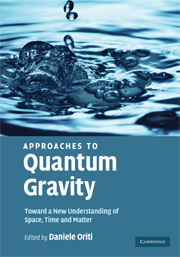Book contents
- Frontmatter
- Contents
- List of contributors
- Preface
- Part I Fundamental ideas and general formalisms
- Part II String/M-theory
- Part III Loop quantum gravity and spin foam models
- Part IV Discrete Quantum Gravity
- Part V Effective models and Quantum Gravity phenomenology
- 22 Quantum Gravity phenomenology
- 23 Quantum Gravity and precision tests
- 24 Algebraic approach to Quantum Gravity II: noncommutative spacetime
- 25 Doubly special relativity
- 26 From quantum reference frames to deformed special relativity
- 27 Lorentz invariance violation and its role in Quantum Gravity phenomenology
- 28 Generic predictions of quantum theories of gravity
- Questions and answers
- Index
28 - Generic predictions of quantum theories of gravity
from Part V - Effective models and Quantum Gravity phenomenology
Published online by Cambridge University Press: 26 October 2009
- Frontmatter
- Contents
- List of contributors
- Preface
- Part I Fundamental ideas and general formalisms
- Part II String/M-theory
- Part III Loop quantum gravity and spin foam models
- Part IV Discrete Quantum Gravity
- Part V Effective models and Quantum Gravity phenomenology
- 22 Quantum Gravity phenomenology
- 23 Quantum Gravity and precision tests
- 24 Algebraic approach to Quantum Gravity II: noncommutative spacetime
- 25 Doubly special relativity
- 26 From quantum reference frames to deformed special relativity
- 27 Lorentz invariance violation and its role in Quantum Gravity phenomenology
- 28 Generic predictions of quantum theories of gravity
- Questions and answers
- Index
Summary
Introduction
How does a proposal for unification go from an interesting body of mathematical results to a plausible explanation of natural phenomena? While evidence of mathematical consistency is ultimately important, what is often decisive is that a proposed unification leads to predictions of phenomena that are both new and generic. By generic I mean that the new phenomena are general consequences of the proposed unification and thus hold for a wide range of parameters as well as for generic initial conditions. The proposal becomes an explanation when some of those new generic phenonena are observed.
Generic consequences of unification often involve processes in which the things unified transform into each other. For example, electromagnetic waves are a generic consequence of unifying electricity and magnetism, weak vector bosons are a generic consequence of unifying the weak and electromagnetic interactions, and light bending is a generic consequence of the equivalence principle which unifies gravity and inertia.
Looking at history, we see that the reasons why proposals for unification succeed or fail often have to do with their generic consequences. In successful cases the consequences do not conflict with previous experiments but are easily confirmed when looked for in new experiments. These are cases in which we come to celebrate the unification. In bad cases the consequences generically disagree with experiment. Some of these cases still survive for some time because the theory has parameters that can be tuned to hide the consequences of the unification.
- Type
- Chapter
- Information
- Approaches to Quantum GravityToward a New Understanding of Space, Time and Matter, pp. 548 - 570Publisher: Cambridge University PressPrint publication year: 2009
- 5
- Cited by

